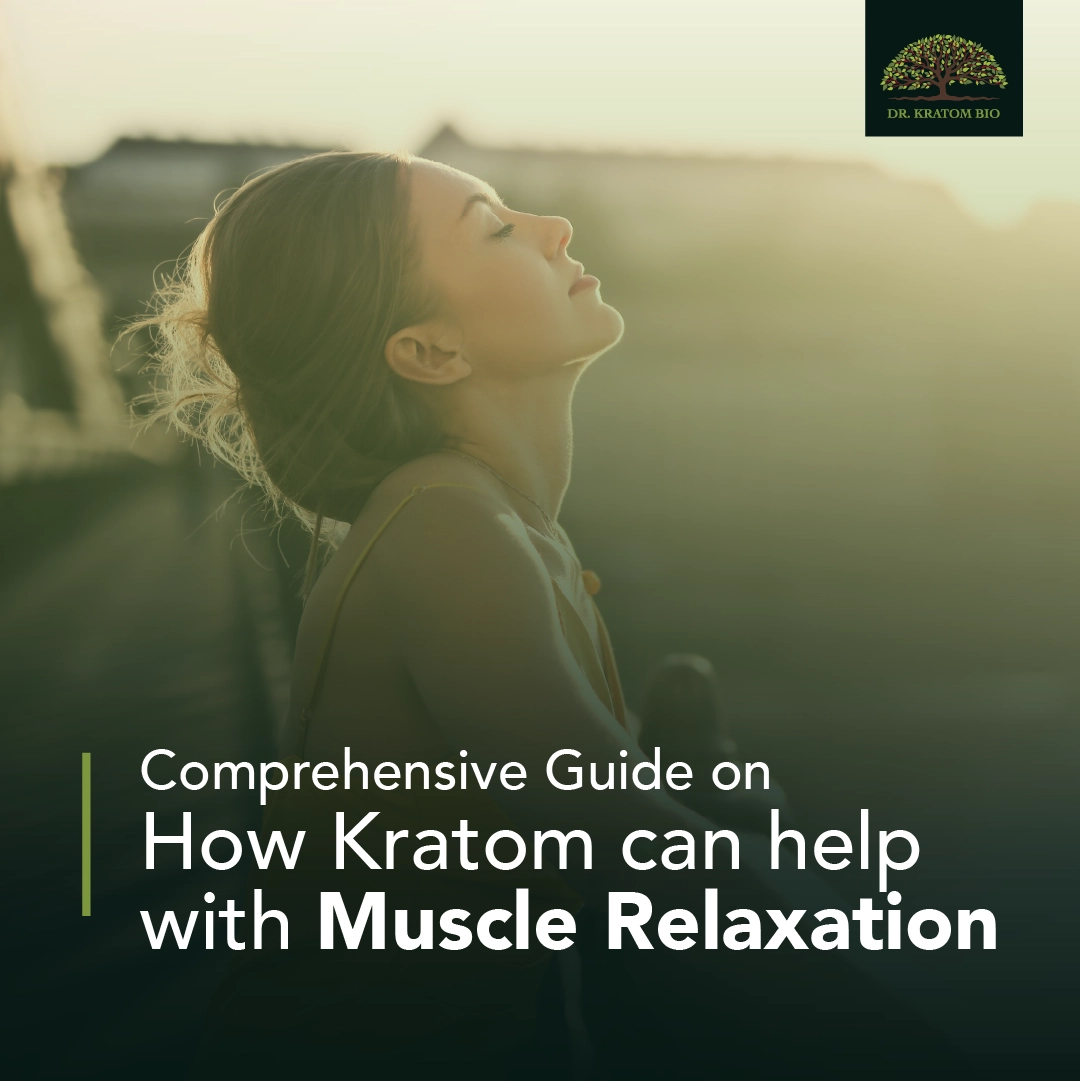Introduction
Kratom, a tropical tree native to Southeast Asia, has gained popularity for its potential therapeutic effects, including pain relief and relaxation. One area where kratom has shown promise is in aiding muscle relaxation. This comprehensive guide explores how kratom can help with muscle relaxation, its potential benefits, usage guidelines, and safety considerations.
Table of Contents
Understanding Kratom
1. What is Kratom?: Kratom (Mitragyna speciosa) is a plant that belongs to the coffee family (Rubiaceae). It has been traditionally used in Southeast Asia for its stimulant and analgesic properties.
2. Kratom Alkaloids and Mechanism of Action: Kratom contains various alkaloids, including mitragynine and 7-hydroxymitragynine, which interact with opioid receptors in the brain. These interactions contribute to kratom’s potential effects on pain relief and relaxation.
Muscle Relaxation and Kratom
How Kratom Affects Muscle Relaxation
Kratom’s alkaloids can potentially influence muscle relaxation through their interaction with opioid receptors. This interaction may lead to decreased muscle tension and a sense of relaxation.
Benefits of Kratom for Muscle Relaxation
- Eases Muscle Tension: Kratom may help reduce muscle tightness and tension, promoting a sense of relaxation.
- Potential Pain Relief: Kratom’s analgesic properties could alleviate discomfort associated with muscle tension or soreness.
Using Kratom for Muscle Relaxation
Choosing the Right Strain
Different kratom strains have varying alkaloid profiles that can influence their effects. Red and some green strains are often favored for relaxation and pain relief.
Proper Dosage
Dosage can vary widely based on individual factors such as tolerance, body weight, and metabolism. It’s recommended to start with a low dose (1-2 grams) and gradually increase as needed, up to a moderate dose (3-5 grams).
Preparation and Consumption
Kratom is commonly consumed in several forms
- Powder: Mix kratom powder with water, juice, or another beverage. Start with a small amount and gradually increase.
- Capsules: Kratom is available in pre-measured capsules, simplifying dosing.
- Tea: Brew kratom leaves or powder into a tea. This method may provide a milder onset of effects.
Safety Considerations
Potential Risks
- Dependence and Withdrawal: Prolonged and high-dose kratom use may lead to dependence and withdrawal symptoms upon discontinuation.
- Interaction with Medications: Kratom’s interaction with medications, especially those affecting the central nervous system, should be carefully considered.
Responsible Usage
- Avoid Overuse: Using kratom sparingly and at appropriate doses can help minimize the risk of adverse effects.
- Stay Hydrated: Kratom can have mild dehydrating effects, so it’s essential to drink enough fluids.
Legal Status and Regulations
Kratom’s legality varies by country and jurisdiction. Research and adhere to local laws and regulations before purchasing or using kratom.
Conclusion
Kratom’s potential as a muscle relaxant is an area of ongoing research and anecdotal evidence. While some individuals may find relief from muscle tension and discomfort through kratom usage, it’s important to approach its use responsibly, starting with low doses, and being aware of potential risks and interactions. Consulting with a healthcare professional before using kratom is advised, especially for those with pre-existing medical conditions or who are taking medications.



16 Comments
sklep internetowy
February 29, 2024Wow, wonderful blog layout! How lengthy have you been running a blog for?
you make running a blog glance easy. The full look of your web site is wonderful, as smartly as the content!
You can see similar: dobry sklep and here najlepszy sklep
najlepszy sklep
March 3, 2024Have you ever considered about including a little bit more than just your articles?
I mean, what you say is valuable and all. Nevertheless think about if you added some great photos
or videos to give your posts more, “pop”! Your content is excellent but with images and videos, this blog
could definitely be one of the greatest in its niche.
Very good blog! I saw similar here: sklep online and also here: najlepszy sklep
dobry sklep
March 14, 2024Excellent post! We are linking to this particularly great post on our site.
Keep up the good writing. I saw similar here: Najlepszy sklep
sklep internetowy
March 24, 2024Hey there! Do you know if they make any plugins to help with
Search Engine Optimization? I’m trying to get
my blog to rank for some targeted keywords but I’m not seeing very good
gains. If you know of any please share. Kudos!
You can read similar art here: Sklep
Analytical & Research Agency
March 25, 2024It’s very interesting! If you need help, look here: ARA Agency
sklep online
March 28, 2024Hey! Do you know if they make any plugins to help with
Search Engine Optimization? I’m trying to get my blog to rank
for some targeted keywords but I’m not seeing very good gains.
If you know of any please share. Cheers! You can read similar text
here: Sklep online
hitman.agency
April 5, 2024Hi there! Do you know if they make any plugins to assist with SEO?
I’m trying to get my blog to rank for some targeted keywords but I’m not
seeing very good gains. If you know of any please share.
Kudos! You can read similar blog here: Hitman.agency
vpn special code
April 8, 2024I like what you guys are usually up too.
Such clever work and reporting! Keep up the excellent
works guys I’ve added you guys to my own blogroll.
vpn special coupon code 2024
April 11, 2024This website certainly has all of the info I needed concerning this subject and didn’t
know who to ask.
dobry sklep
April 16, 2024Wow, amazing blog format! How lengthy have you ever been running a blog for?
you made running a blog look easy. The full glance of your web site is great, as smartly as the content material!
You can see similar here sklep online
Fae73
April 20, 2024Wow, amazing weblog format! How lengthy have you been running
a blog for? you made running a blog look easy. The whole look of your web
site is excellent, as smartly as the content material!
I read similar here prev next and that was wrote by Malinda65.
Jung90
April 20, 2024Wow, wonderful weblog layout! How long have you ever
been blogging for? you made running a blog look easy.
The total look of your website is great, as neatly as the
content material! I saw similar here prev next and
it’s was wrote by Loyd72.
Cheri70
April 22, 2024Wow, superb weblog layout! How lengthy have you ever
been blogging for? you made blogging glance easy.
The total look of your site is excellent, let
alone the content material! I read similar here prev next
and that was wrote by Louann83.
EarlDes
April 23, 2024Wow, awesome blog structure! How long have you been running a
blog for? you made blogging look easy. The entire look of your web site is wonderful, let alone
the content material! I saw similar here prev next and
those was wrote by Wesley93.
Dacia Jaj6
April 23, 2024Wow, incredible weblog structure! How long have you ever been running a blog for?
you made blogging glance easy. The entire look of your web site is wonderful, let alone the content!
You can read similar here Dacia Jaj6. 2024/04/23
facebook vs eharmony to find love online
May 16, 2024Hi there! Quick question that’s completely off topic.
Do you know how to make your site mobile friendly?
My site looks weird when browsing from my iphone 4. I’m trying to find a
template or plugin that might be able to correct this problem.
If you have any suggestions, please share. Thanks!